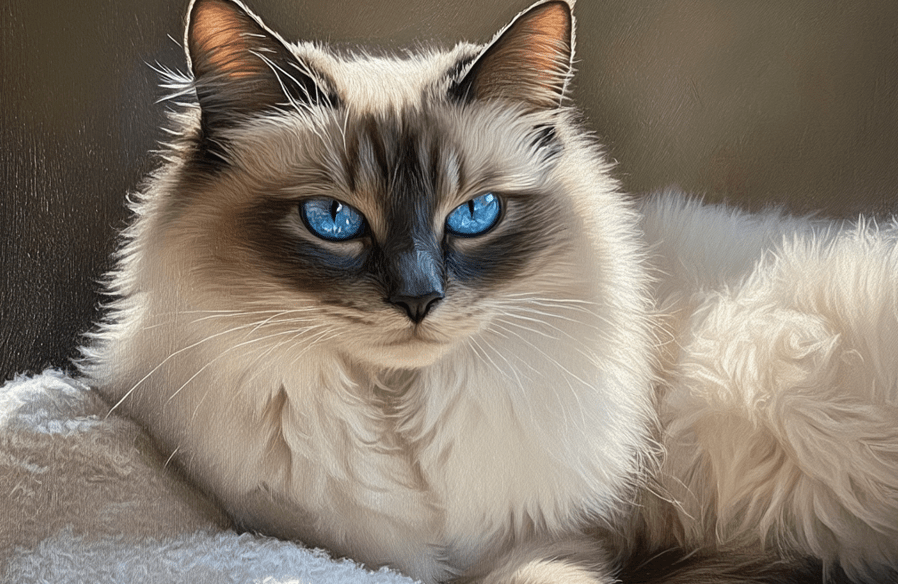
Ragdoll cat hiding is a behavior that can worry even the most experienced cat owners. Known for their affectionate, social nature, Ragdolls typically love being around their humans. So, when your Ragdoll starts retreating to secluded spots, it’s a sign that something might be off. This comprehensive guide explores the reasons behind Ragdoll cat hiding, from stress to health issues, and provides actionable, compassionate solutions to help your feline friend feel safe and secure again. With expert insights and practical tips, you’ll learn how to support your Ragdoll’s emotional and physical well-being.
Understanding Ragdoll Cat Hiding Behavior
Ragdolls are a unique breed, cherished for their docile temperament, striking blue eyes, and plush coats. Their nickname, “puppy cats,” reflects their tendency to follow owners around and seek attention. However, even these sociable cats may hide occasionally. Hiding is a natural feline instinct, often triggered by a need for safety, rest, or self-regulation. For Ragdolls, Ragdoll cat hiding can signal anything from temporary discomfort to a deeper issue requiring attention.

Hiding becomes concerning when it’s frequent, prolonged, or accompanied by other changes, such as reduced appetite or aggression. Understanding the root cause is the first step to helping your Ragdoll feel comfortable and confident again.
Common Reasons Why Ragdoll Cats Hide
To address Ragdoll cat hiding, it’s essential to identify the underlying cause. Here are the most common reasons Ragdolls may seek solitude:
1. Stress or Anxiety
Ragdolls are sensitive to changes in their environment. Stressors like moving, new pets, loud noises, or unfamiliar visitors can prompt hiding. Their gentle nature makes them particularly prone to feeling overwhelmed.
2. Health Issues
Pain or illness often causes cats to hide as a protective mechanism. Conditions like dental problems, urinary tract infections, or arthritis may make your Ragdoll seek quiet, secluded spots. Ragdolls are prone to certain genetic conditions, such as hypertrophic cardiomyopathy (HCM), which can affect their behavior.
3. Environmental Changes
Rearranging furniture, introducing new household items, or even changing litter brands can unsettle a Ragdoll. They thrive on routine, and disruptions may lead to hiding as they adjust.
4. Boredom or Lack of Stimulation
Ragdolls are intelligent and need mental and physical engagement. Without enough playtime or enrichment, they may retreat out of boredom or frustration.
5. Territorial Instincts
Despite their laid-back demeanor, Ragdolls can be territorial. The presence of another pet or perceived threats to their space may drive them to hide in a safe spot.
6. Natural Instincts
Cats, including Ragdolls, instinctively hide to rest or observe their surroundings. Occasional hiding in cozy spots like under beds or in closets is normal, especially for a breed that loves comfort.
How to Help Your Ragdoll Cat Stop Hiding
Once you’ve identified the potential cause of Ragdoll cat hiding, you can take steps to address it. The following strategies focus on creating a supportive environment, reducing stress, and ensuring your Ragdoll’s health and happiness.

1. Create Safe and Comfortable Spaces
Ragdolls need secure areas where they feel protected but not isolated. Providing safe spaces encourages them to emerge on their terms.
Cozy Hideaways: Offer cat beds, igloos, or cardboard boxes lined with soft blankets in quiet areas. Place these in low-traffic zones to give your Ragdoll a sense of security.
Vertical Spaces: Ragdolls love perching. Install cat shelves or a tall cat tree where they can observe their surroundings without feeling exposed.
Scent Familiarity: Place items with familiar scents, like your worn clothing or their favorite blanket, in their hiding spots to provide comfort.
2. Minimize Stress Triggers
Reducing stressors in your Ragdoll’s environment can help them feel safe enough to stop hiding.
Gradual Introductions: If introducing a new pet or person, do so slowly. Allow your Ragdoll to approach at their own pace, using treats or toys to create positive associations.
Quiet Environment: Minimize loud noises, such as vacuum cleaners or music, during times when your Ragdoll is most active. Use white noise machines to mask disruptive sounds.
Consistent Routine: Maintain a predictable schedule for feeding, playtime, and litter box cleaning. Consistency helps Ragdolls feel secure.
Pheromone Diffusers: Products like Feliway release calming pheromones that mimic a cat’s natural scent, reducing anxiety. Place diffusers in areas where your Ragdoll spends time.
3. Schedule a Veterinary Checkup
If hiding is sudden, frequent, or paired with symptoms like lethargy, loss of appetite, or litter box issues, a vet visit is crucial.
Health Screening: Ask your vet to check for common Ragdoll health issues, such as HCM, kidney disease, or dental problems. Bloodwork, imaging, or dental exams may be needed.
Pain Assessment: Cats hide when in pain. Your vet can evaluate for conditions like arthritis or urinary issues that may not be immediately obvious.
Behavioral Consultation: Some vets specialize in feline behavior. They can help distinguish between medical and emotional causes of hiding.
4. Provide Mental and Physical Stimulation
Engaging your Ragdoll’s mind and body can prevent boredom and encourage them to stay active instead of hiding.
Interactive Toys: Use feather wands, laser pointers, or puzzle toys to stimulate your Ragdoll’s hunting instincts. Rotate toys regularly to maintain interest.
Daily Playtime: Dedicate 15-20 minutes twice daily to play with your Ragdoll. Morning and evening sessions align with their natural activity peaks.
Enrichment Activities: Set up a window perch for bird-watching or hide treats around the house for a scavenger hunt. These activities tap into their curiosity and encourage exploration.
Training: Teach your Ragdoll simple tricks like “sit” or “come” using positive reinforcement. Training strengthens your bond and boosts their confidence.
5. Build Trust Through Positive Reinforcement
Ragdolls respond well to gentle, positive interactions. Building trust can coax them out of hiding and reinforce their social nature.
Respect Their Space: Avoid forcing your Ragdoll out of their hiding spot. Instead, sit nearby, speak softly, or offer treats to lure them out voluntarily.
Reward Confidence: When your Ragdoll emerges, reward them with praise, pets, or treats. This reinforces the idea that being out in the open is safe and rewarding.
Bonding Activities: Spend quality time grooming, playing, or simply sitting with your Ragdoll. Their love for human interaction can outweigh their urge to hide.
Avoid Punishment: Never scold or punish your Ragdoll for hiding, as this can increase anxiety and worsen the behavior.
Additional Tips for Supporting a Hiding Ragdoll
Monitor Multi-Cat Dynamics: In households with multiple cats, ensure each has their own resources (litter boxes, beds, feeding stations) to prevent territorial conflicts that may cause hiding.
Check for Environmental Toxins: Household items like certain plants, cleaning products, or essential oils can cause discomfort, prompting hiding. Ensure your home is cat-safe.
Adjust Lighting: Ragdolls may hide in overly bright or dark spaces. Use soft, natural lighting to create a calming atmosphere.
Track Behavior Patterns: Keep a journal of when and where your Ragdoll hides, along with any triggers. This can help identify patterns and tailor solutions.
Consider Companionship: If your Ragdoll is alone for long periods, boredom or loneliness may contribute to hiding. A compatible feline companion or increased human interaction can help.
Common Mistakes to Avoid

Ignoring Health Issues: Assuming hiding is “just a phase” can delay diagnosis of serious conditions. Always rule out medical causes first.
Forcing Interaction: Dragging your Ragdoll out of hiding can erode trust. Let them emerge on their own terms.
Overlooking Stressors: Small changes, like a new air freshener or rearranged furniture, can stress a Ragdoll. Pay attention to their environment.
Inconsistent Routines: Sporadic feeding or play schedules can increase anxiety, making hiding more likely.
Neglecting Enrichment: Without mental stimulation, Ragdolls may retreat out of boredom. Ensure their environment is engaging.
When to Seek Professional Help
If your Ragdoll’s hiding persists despite your efforts, or if it’s accompanied by concerning symptoms, seek professional assistance:
Veterinarian: For health-related concerns, a vet can conduct thorough exams and recommend treatments or referrals.
Feline Behaviorist: A certified cat behaviorist can assess your Ragdoll’s environment and behavior, offering tailored strategies to reduce hiding.
Groomer or Trainer: If hiding is linked to grooming discomfort or lack of confidence, professionals can help create positive experiences.
Why Addressing Ragdoll Cat Hiding Matters
Ragdolls are more than just beautiful pets; they’re loyal companions who thrive on connection. Ragdoll cat hiding is a signal that your cat needs support, whether it’s emotional, physical, or environmental. By addressing the root cause and creating a nurturing environment, you’re not only helping your Ragdoll feel safe but also deepening your bond. A confident, engaged Ragdoll is a joy to have, and your efforts will lead to a happier, healthier feline friend.
Conclusion

Understanding why your Ragdoll cat is hiding and knowing how to help is key to restoring their confidence and well-being. By creating safe spaces, minimizing stress, ensuring their health, providing stimulation, and building trust, you can encourage your Ragdoll to embrace their social, playful nature. Start with small, consistent steps, observe their responses, and be patient as they adjust. With your care and attention, your Ragdoll will feel secure enough to leave their hiding spots and enjoy life by your side.




